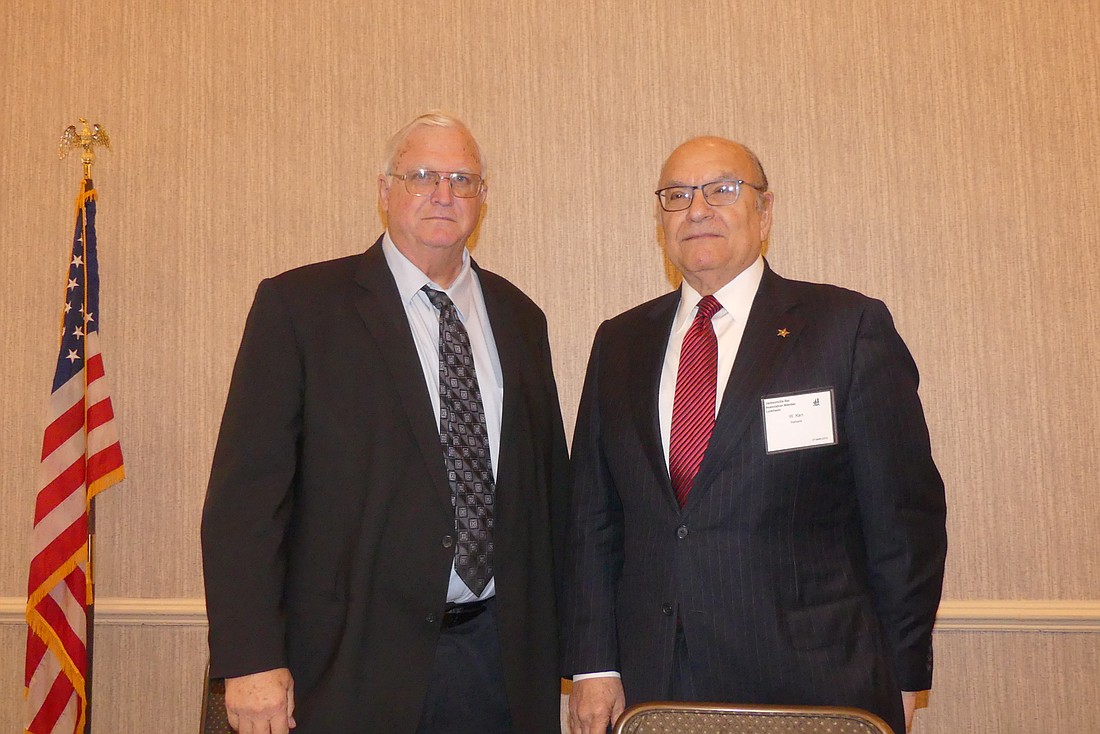
Theodore “Ted” Bundy was executed 30 years ago after being convicted of murdering two young women in Tallahassee and kidnapping and murdering a 12-year-old girl in Lake City.
Two of the law enforcement officials who helped usher Bundy to the state’s electric chair in 1989 were the keynote speakers last week at the Jacksonville Bar Association’s membership meeting.
Before he was executed, Bundy confessed to 30 murders in a cross-country spree that stretched from Washington State, Utah and Colorado to Florida and lasted nearly five years.
“Thankfully, Bundy was a once-in-a-lifetime problem,” said George Dekle Sr., a retired 3rd Judicial Circuit assistant state attorney who prosecuted Bundy for the kidnapping and first-degree murder of 12-year-old Kimberly Leach in Lake City.
It was Dekle’s first murder prosecution.
A professor at the University of Florida Levin College of Law after he retired from state service, he’s the author of “The Last Murder: The Investigation, Prosecution and Execution of Ted Bundy.”
The book recounts the on-the-job training Dekle received as a young assistant state attorney while preparing for and trying the case that he described as comparable to the Lindbergh kidnapping case or O.J. Simpson’s trial for double murder.
“Some people have commented that there’s not enough Bundy in the book. I wrote the book for prosecutors,” Dekle said.
He said was “unprepared” for such a massive case and that for most of the murder cases he tried in his career, his notes preparing for trial usually filled no more than a few pages of a legal pad.
For Bundy, Dekle’s trial brief was 1,700 pages of information that he had to present to a jury selected on the basis of its members not being familiar with the extensive publicity associated with the high-profile defendant.
“I had to communicate it to 12 people chosen off the street for being dumb and not reading a newspaper or watching television,” Dekle said.
The challenge for retired Leon County Sheriff Ken Katsaris came when he took Bundy into custody when he was charged with the murder of two young women at the Chi Omega sorority house at Florida State University.
Bundy had previously escaped from custody in two states, once by jumping out of the window of the law library at a Colorado courthouse.
When he arrived in Tallahassee about a week before committing the murders, Bundy was on the run after another escape in Colorado, where he cut a hole in the ceiling of his cell and escaped through a crawl space into an unguarded room and fled.
Katsaris said he had Bundy’s cell in Leon County modified to make it “armor-plated.” It had three locks with three keys held by three jailers.
Bundy was held in the cell nearly 24/7 to ensure maximum security. When he was allowed one hour of exercise outside the building three times a week, Katsaris said he instituted unusual procedures for that as well.
“I told him he had to stay in the middle of the exercise yard. There was an officer with a loaded shotgun with the safety off pointed at him and there were two high-powered rifles with scopes aimed at him. We had two K-9s that already had his scent from his clothes. I told him ‘if you put both hands on that fence, you’re dead,’” Katsaris said.
“I wasn’t going to lose him.”
Katsaris said he learned something about federal judges while he had Bundy in custody.
Bundy chose to represent himself at the trial and petitioned the court for the right to be transported to FSU, where he could use the law library for research.
“I told the judge, ‘over my dead body.’ ” He told me, ‘then prepare to die, sheriff,’” Katsaris said.
Katsaris said the Bundy case set legal precedent in terms of gathering evidence and then getting it admitted in court.
The medical examiner documented double human bite marks on one of the two women murdered at Chi Omega.
“He (Bundy) would taunt me that the evidence was there. It is my opinion that Ted Bundy ‘signed’ that young lady,” Katsaris said.
A judge granted a search warrant to allow removal of “any evidence” from Bundy’s mouth, the first time such an order was granted in the U.S., Katsaris said.
Bundy was taken to a dentist’s office, where an impression was made of his teeth. The casting exactly matched the bite marks on the victim.
It was “the only piece of physical evidence we had,” Katsaris said, and it was key to convicting Bundy.
Katsaris said it also was the first time in U.S. history that bite marks were introduced as evidence in court.
Katsaris and Dekle commented on what they did Jan. 24, 1989 – the day Ted Bundy was executed after exhausting his appeal process.
Katsaris said he got a telephone call from Gov. Bob Martinez indicating that although Bundy had been sentenced to death in all three cases, Martinez would sign the death warrant for the murder of the youngest victim.
“She was only 12 years old. I’m glad he was executed for the death of Kimberly Leach,” Katsaris said.
Dekle said he indicted a multiple murder defendant the day Bundy was executed, and “the first case took two years to prepare. The second case, I did it in my spare time, based on what I learned (prosecuting Bundy).”